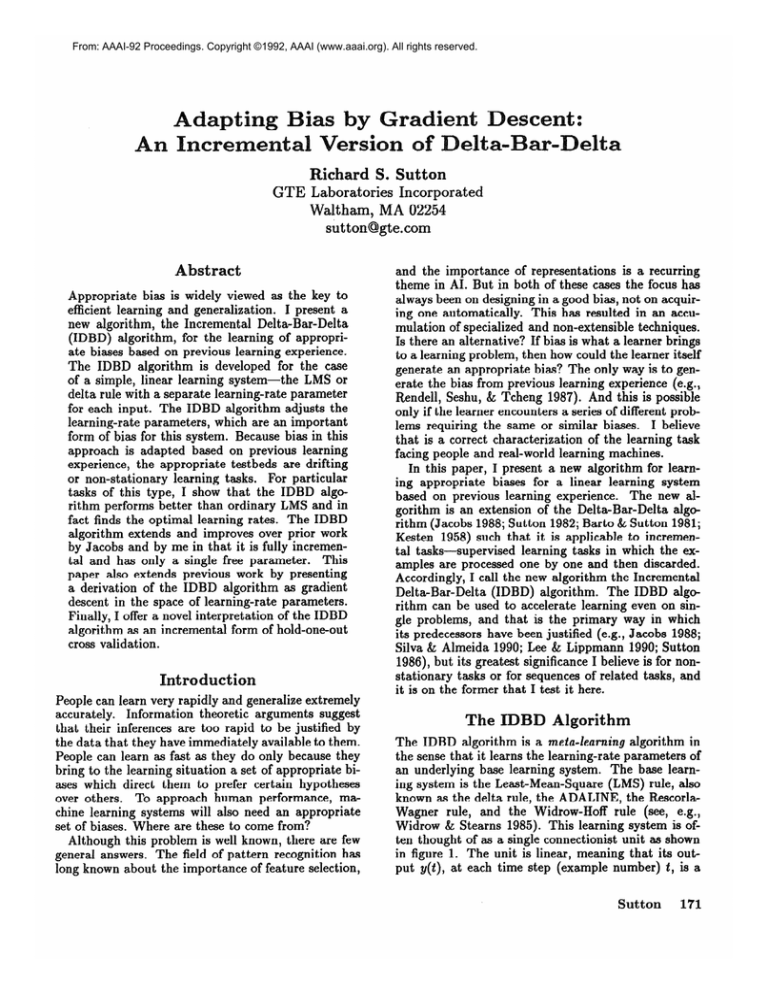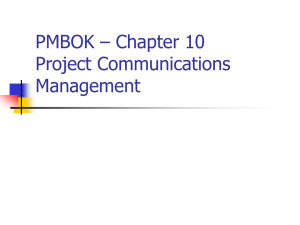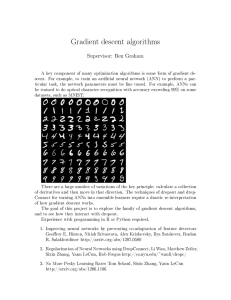
From: AAAI-92 Proceedings. Copyright ©1992, AAAI (www.aaai.org). All rights reserved.
ichard S. Sutton
GTE Laboratories Incorporated
Waltham, MA 02254
sutton@gte.com
Abstract
Appropriate bias is widely viewed as the key to
efficient learning and generalization. I present a
new algorithm, the Incremental Delta-Bar-Delta
(IDBD) algorithm, for the learning of appropriate biases based on previous learning experience.
The IDBD algorithm is developed for the case
of a simple, linear learning system-the
LMS or
delta rule with a separate learning-rate parameter
for each input. The IDBD algorithm adjusts the
learning-rate parameters, which are an important
form of bias for this system. Because bias in this
approach is adapted based on previous learning
experience, the appropriate testbeds are drifting
or non-stationary learning tasks. For particular
tasks of this type, I show that the IDBD algorithm performs better than ordinary LMS and in
fact finds the optimal learning rates. The IDBD
algorithm extends and improves over prior work
by Jacobs and by me in that it is fully incremental and has only a single free parameter. This
paper also extends previous work by presenting
a derivation of the IDBD algorithm as gradient
descent in the space of learning-rate parameters.
Finally, I offer a novel interpretation of the IDBD
algorithm as an incremental form of hold-one-out
cross validation.
People can learn very rapidly and generalize extremely
accurately. Information theoretic arguments suggest
that their inferences are too rapid to be justified by
the data that they have immediately available to them.
People can learn as fast as they do only because they
bring to the learning situation a set of appropriate biases which direct them to prefer certain hypotheses
over others. To approach human performance, ma
chine learning systems will also need an appropriate
set of biases. Where are these to come from?
Although this problem is well known, there are few
general answers. The field of pattern recognition has
long known about the importance of feature selection,
and the importance of representations is a recurring
theme in AI. But in both of these cases the focus has
always been on designing in a good bias, not on acquiring one automatically. This has resulted in an accumulation of specialized and non-extensible techniques.
Is there an alternative? If bias is what a learner brings
to a learning problem, then how could the learner itself
generate an appropriate bias? The only way is to generate the bias from previous learning experience (e.g.,
Rendell, Seshu, & Tcheng 1987). And this is possible
only if the learner encounters a series of different problems requiring the same or similar biases. I[ believe
that is a correct characterization of the learning task
facing people and real-world learning machines.
In this paper, I present a new algorithm for learning appropriate biases for a linear learning system
based on previous learning experience. The new algorithm is an extension of the Delta-Bar-Delta algorithm (Jacobs 1988; Sutton 1982; Barto & Sutton 1981;
Kesten 1958) such that it is applicable to incremental tasks-supervised
learning tasks in which the examples are processed one by one and then discarded.
Accordingly, I call the new algorithm the Incremental
Delta-Bar-Delta (IDBD) algorithm. The IDBD algorithm can be used to accelerate learning even on single problems, and that is the primary way in which
its predecessors have been justified (e.g., Jacobs 1988;
Silva & Almeida 1990; Lee & Lippmann 1990; Sutton
1986), but its greatest significance I believe is for nonstationary tasks or for sequences of related tasks, and
it is on the former that I test it here.
The 1
Algorithm
The IDBD algorithm is a meta-learning algorithm in
the sense that it learns the learning-rate parameters of
an underlying base learning system. The base learning system is the Least-Mean-Square (LMS) rule, also
known as the delta rule, the ADALINE, the RescorlaWagner rule, and the Widrow-Hoff rule (see, e.g.,
Widrow & Stearns 1985). This learning system is often thought of as a single connectionist unit as shown
in figure 1. The unit is linear, meaning that its output y(t), at each time step (example number) t, is a
Sutton
171
This exponential relationship between the learning
rate, oi, and the memory parameter that is actually
modified, pi, has two advantages. First, it is a natural
way of assuring that ai will always be positive. Second,
it is a mechanism for making geometric steps in oi: if
pi is incremented up and down by a fixed step-size,
then oi will move up or down by a fixed fraction of
its current value, e.g., up or down by 10%. This is desirable because some ai must become very small while
others remain large; no fixed step-size would work well
for all the oi.
The IDBD algorithm updates the pi by
Pi(t
Figure 1: The base-level learning system is a single
linear unit using the LMS or delta rule.
weighted sum of its real-valued inputs xi(t):
y(t)
= g
W(t)%(t),
kl
were each w;(t) is the value at time t of a modifiable
weight wi a&oLiated with zi. At each time step, the
learner receives a set of inputs, Xi(t), computes its output, y(t), and compares it to a given desired output,
y*(t). The aim of learning is to minimize the squared
error S2(t), where 6(t) = y*(t) - y(t), on future time
steps. The LMS learning rule updates the weights at
each time step according to:
Wi(t
+
1)
=
W(t)
+
aS(t)Xi(t)j
(2)
where Q!is a positive constant called the learning rate.
In the IDBD algorithm there is a different learning
rate, oi, for each input xi, and these change according
to a meta-learning process (cf. Hampson & Volper
1986). The base-level learning rule is ’
Wi(t + 1) = Wi(t) + CYi(t + l)S(t)Xi(t).
(3)
The learning rates are a powerful form of bias in this
system. Learning about irrelevant inputs acts as noise,
interfering with learning about relevant inputs.
A
rough rule of thumb is that learning time is proportional to the sum of the squares of the learning rates
(assuming all inputs have equal variance; see \Nidrow
& Stearns 1985). In effect, learning rates are a valuable resource that must be distributed carefully. Inputs that are likely to be irrelevant should be given
small learning rates, whereas inputs that are likely to
be relevant should be given large learning rates.
In the IDBD algorithm, the learning rates are all of
the form
c&(t) = ,fl@).
(4
‘The cr; are indexed by t + 1 rather than t simply to
indicate that their update, by a process described below,
occurs before the wi update (see figure 2).
172
Learning:
Neural
Network
and Hybrid
1)
=
Pi(t)
+
@S(t)zi(t)h(t),
(5)
where 0 is a positive constant, the meta-learning rate,
and hi is an additional per-input memory parameter
updated by
hi(t+l)
(1)
+
= hi(t) [ l-ai(t+l)xf(t)]
++ai(t+l)6(t)xi(t),
(6)
where [XI+ is x, if x > 0, else 0. The first term
in the above equation is a decay term; the product
ai(t + 1)$(t) is normally zero or a positive fraction,
so this term causes a decay of hi towards zero. The
second term increments hi by the last weight change
(cf. (3)). The memory hi is thus a decaying trace of
the cumulative sum of recent changes to wi.
The intuitive idea behind the IDBD algorithm is a
simple one. Note that the increment to pi in (5) is proportional to the product of the current weight change,
b(t)xi(t),
and a trace of recent weight changes, hi(t).
By accumulating this product, the overall change in &
becomes proportional to the correlation between current and recent weight changes. If the current step
is positively correlated with past steps, that indicates
that the past steps should have been larger (and equation (5) accordingly increases pi). If the current step
is negatively correlated with past steps, that indicates
that the past steps were too large; the algorithm is
overshooting the best weight values and then having
to m-correct in the opposite direction (here equation
(5) decreases pi).
The intuitive idea of the IDBD algorithm as described above is the same as that of Jacob’s (1988)
Delta-Bar-Delta algorithm. The primary difference is
that Jacobs’s algorithm can be applied only on a batchby-batch basis, with updates after a complete presentation of a training set, whereas here we assume examples arrive one-by-one and are not necessarily revisited
afterwards. The key to making the new algorithm incremental is the way the trace hi is defined such that
it fades away only to the extent that the corresponding input xi is present, as indicated by x”(t). The new
algorithm also improves over Jacobs’s in that the de=aY rate is not a separate free parameter, but is tied to
the current learning rate. The new algorithm in fact
has only one free parameter, the metalearning rate, 8,
whereas Jacobs’s algorithm has three free parameters.
Initialize hi to 0, and wi, pi as desired, i = I, . . . , n
Repeat for each new example (2 1, . . . , x,, , y* ) :
j/ +
n
xi=1
WXi
Sty”-y
Repeat for i=
l,...,n:
pi +
pi + BSxihi
Qli 4- e Bi
Wi *
Wi + CviSXi
hi +
hi + [I -
aixf]+
+ CviSxi
0.005
0.010
0.015
0.020
Figure 2: The IDBD Algorithm in Pseudocode
Qn the other hand, Jacobs’s algorithm was designed
for nonlinear networks. While I do not foresee great
difficulties extending the IDBD algorithm to the nonlinear case, that is beyond the scope of this paper.
In practice, it is often useful to bound each pi from
below by, say, -IO, to prevent arithmetic underflows.
In addition, it is prudent to limit the change in /3i on
any one step to, say, f2. However, these boundings
were not required to obtain the empirical results presented in the next section.
The capabilities of the IDBD algorithm were assessed
using a series of tracking tasks-supervised-learning
or concept-learning tasks in which the target concept
drifts over time and has to be tracked (cf. Schlimmer
1987). Non-stationary tasks are more appropriate here
than conventional learning tasks because we are trying
to assess the IDBD algorithm’s ability to learn biases
during early learning and then use them in later learning. To study this one needs a continuing learning
problem, not one that can be solved once and is then
finished.
Experiment
1: Does
I
help?
Experiment 1 was designed to answer the question:
Does the IDBD algorithm perform better than the ordinary LMS algorithm without IDBD? The task involved 20 real-valued inputs and one output. The inputs were chosen independently and randomly according to a normal distribution with mean zero and unit
variance. The target concept was the sum of the first
five inputs, each multiplied either by +l or -I, i.e.:
y*
=
51x1+
+
8212 +
s3x3 +
54x4 i- @ix5
~~6+~~7+*-+~~20,
where all the si are either + 1 or - 1. To make it a
tracking problem, every 20 examples one of the five
si was selected at random and switched in sign, from
+l to -1, or vice versa. Thus, the same five inputs
were always relevant, but their relationship to the target concept occasionally changed. If the IDBD algorithm can successfully identify which inputs are rele-
Figure 3: Comparison of the average asymptotic performances of IDBD and LMS algorithms over the relevant ranges of their step-size parameters (QI, upper
axis, for LMS, and 0, lower axis, for IDBD). The IDBD
algorithm results in less than half the level of error over
a broad range of values of its step-size parameter. For
parameter values above those shown, both algorithms
can become unstable.
vant, then it should be able to track the drifting target
function more accurately than ordinary LMS.
Because this is a tracking task, it suffices to perform one long run and measure the asymptotic tracking performance of the algorithms. In this experiment
I ran each algorithm for 20,000 examples so as to get
past any initial transients, and then ran another 10,000
examples. The average mean-squared error over that
10,000 examples was used as the asymptotic performance measure of the algorithm. The algorithms used
were ordinary LMS with a range of learning rates and
the IDBD algorithm with a range of meta-learning
rates. The pi in the IDBD algorithm were set initially
such that tyi = 0.05, for all a’(but of course this choice
has no affect on asymptotic performance).
The results for both algorithms are summarized in
figure 3. With its best learning rate, ordinary LMS
attains a mean squared error of about 3.5, while the
IDBD algorithm performs substantially better over a
wide range of 0 values, attaining a mean squared error of about 1.5. The standard errors of all of these
means are less that 0.1, so this difference is highly statistically significant. The IDBD algorithm apparently
learns biases (learning rates) that enable substantially
more accurate tracking on this task.
find the optimal a;?
Exp. 2:
Experiment I shows that the IDBD algorithm finds a
distribution of learning rates across inputs that is better than any single learning rate shared by all, but it
does not show that it finds the best possible distribution of learning rates. While this may be difficult to
show as a general result, it is relatively easy to confirm
empirically for special cases. To do this for the task
used in Experiment 1, I chose a small value for the
Sutton
173
L
.
0
-.i= 1.8 2
IRRELEVANT
et
1
looK
2flw
3.6
1
31.4
a
:
1
25By
TIME STEPS (# Examples)
Figure 4: Time course of learning-rate parameters, under IDBD, for one relevant and one irrelevant input.
meta-learning rate, 8 = 0.001, and ran for a very large
number of examples (250,000) to observe the asymptotic distribution of learning rates found by the algorithm (as before, the learning rates were initialized to
0.05). Figure 4 shows the behavior over time of two of
the cyi, one for a relevant input and one for an irrelevant input.
After 250,000 steps, the learning rates for the 15 irrelevant inputs were all found to be less than 0.007
while the learning rates for the 5 relevant inputs were
all 0.13f0.015. The learning rates for the irrelevant inputs were apparently heading towards zero (recall that
they cannot be exactly zero unless /3i = -oo), which is
clearly optimal, but what of the relevant inputs? They
should all share the same optimal learning rate, but
is it @ 0.13, as found by the IDBD algorithm, or is it
some other value? We can determine this empirically
simply by trying various sets of fixed learning rates.
The irrelevant inputs were all given fixed zero learning
rates and the relevant inputs were fixed at a variety of
values between 0.05 and 0.25. Again I ran for 20,000
examples, to get past transients, and then recorded the
average squared error over the next 10,000 examples.
The results, plotted in figure 5, show a clear minimum
somewhere near 0.13f0.01, confirming that the IDBD
algorithm found learning rates that were close to optimal on this task.
Derivation of the IDBD Algorithm
as Gradient Descent
Many useful learning algorithms can be understood as
gradient descent, including the LMS rule, backpropagation, Boltzmann machines, and reinforcement learning methods. Gradient descent analysis can also be
used to derive learning algorithms, and that in fact is
the way in which the IDBD algorithm was invented. In
this section I derive the IDBD algorithm as gradient
descent.
To illustrate the basic idea of gradient-descent analysis, it is useful to first review how the base learn174
Learning:
Neural
Network
and Hybrid
Figure 5: Average error as a function of the learningrate parameter of the relevant inputs (the irrelevant
inputs had zero learning-rate parameters).
Error is
minimized near CY= 0.13, the value found by the IDBD
algorithm.
ing rule, the LMS rule (2), can be derived as gradient descent. Recall that we are trying to minimize
the expected value of the squared error S2(t), where
b(t) = y*(t) - y(t). The expected error as a function
of the weights forms a surface. In gradient descent, a
current value for w is moved in the opposite direction
of the slope of that surface. This is the direction in
which the expected error falls most rapidly, the direction of steepest descent. Because the expected error
is not itself-known, we use instead the gradient of the
sample error S2(t):
Wi(t
+
1) =
Wi(t)
-
1
ass(t)
2
aWi(t)’
-CY-
(7)
The scalar quantity $X is the step-size, determining
how far the weight vector moves in the direction of
steepest descent. The 3 drops out as we expand the
righthand side:
Wi(t + 1)
1
S2(t)
=
Wi(t)
-
--cY2 aWi(t)
=
Wi(t)
-
OS(t)-
Wt)
@W(t)
=
Wi(t)
-
&S(t)
=
Wi(t)
+ OS(t)-
a[Y*(o - YWI
d?&(t)
(8)
aY(t)
dwi
(t)
=
=
W(t)
+
aS(t)
thus deriving the LMS rule (2).
The derivation for the IDBD algorithm is very similar in principle. In place of (7), we start with
&(t + 1) = @i(t)- :Op,
i
(9)
It is often not recognized that the size of the step in
the direction of the gradient may depend on the current value of the parameters being modified. Moreover,
even the direction of the step can be changed, as long
as it it is in the same general direction as the gradient (positive inner product), without losing these key
properties.2 For example, one could add a factor of 4,
for any p, to the increment of /3i in (9) to obtain an entire new family of algorithms. In fact, experiments in
progress suggest that some members of this family may
be more efficient than the IDBD algorithm at finding
optimal learning rates. There is little reason beyond
simplicity for prefering the IDBD algorithm over these
other possibilities a priori.
The gradient analysis presented in this section tells
us something about the IDBD algorithm, but it may
also tell us something about incremental bias-learning
algorithms in general. In particular, it suggests how
one might derive bias-learning algorithms for other
base learning methods, such as instance-based learning methods. In instance-based learning systems an
important source of bias is the parameters of the interinstance distance metric. Currently these parameters
are established by people or by offline cross-validation
methods. An interesting direction for further research
would be to attempt to repeat the sort of derivation
presented here, but for instance-based methods.
where now $0 is the (meta) step-size. In this equation, the partial derivitive with respect to pi without
a time index should be interpretted as the derivative
with repect to an infintesimal change in pi at all time
steps. A similar technique is used in gradient-descent
analyses of recurrent connectionist networks (c.f., e.g.,
Williams & Zipser 1989). We then similarly rewrite
and expand (9) as:
Pi(t
+1)= Pi(t)
- fez--
ab2(t)
8th
aWj(t)
j
Rs
BWj(t)
1 86’(t)
aWj(t)
ijgawi(r)x.
Pitt)-
00)
The approximation above is reasonable in so far as the
primary effect of changing the ith learning rate should
be on the ath weight. Thus we assume $@
From (8) we know that -?jis
i # j.
NN0 for
= h(t)Xj(t);
therefore we can rewrite (10) as
pi(t + 1) m ,4(t) + @s(t)xi(t)hi(t),
where hi(t) is defined as p.
is in turn derived as follows:’
aWi(t
hi(t
+
1)
+
=
(11)
The update rule for hi
1)
ap
i
0
=api
=
Wj(t)
+ ePict+l)6(t)Xj(t)]
hi(t) + @i(t+l)b(t)xi(t)
(12)
+ 8i(t+1)
WI
-xi(t),
ap
i
using the product rule of calculus. Using the same
approximation as before (in (lo)), we write
W)
=
aPi
m
--
W)
aI%
-- a:
i
=
-6
C
Wj(t)Xj(t)
’ i
[tui(t)xi(t)]
= -hi(t)xi(t)-
Finally, plugging this back into (12) yields
hi(t+ 1)
w
m
hi(t) + t8i”+“a(t)zi(t)
r
hi(t) [I-
-
e’i(t+l),f(t)hi(t)
‘I
cQ(t + I)xf(t)] +oi(t
+ l)b(t)zi(t),
which, after adding a positive-bounding operation, is
the original update rule for hi, (6), while the derived
update (11) for pi is the same as (5).
The above demonstrates that the IDBD algorithm is
a form of stochastic gradient descent in the learningrate parameters pi. In other words, the algorithm will
tend to cause changes according to their effect on overall error. At local optima, the algorithm will tend to be
stable; elsewhere, it will tend to reduce the expected
error. These might be considered necessary properties
for a good learning algorithm, but they alone are not
sufficient. For example, there is the issue of step-size.
Conchsion
The results presented in this paper provide evidence
that the IDBD algorithm is able to distinguish relevant
from irrelevant inputs and to find the optimal learning
rates on incremental tracking tasks. Depending on the
problem, such an ability to find appropriate biases can
result in a dramatic reduction in error. In the tasks
used here, for example, squared error was reduced by
approximately 60%. The IDBD algorithm achieves this
while requiring only a linear increase in memory and
computation (both increase by roughly a factor of three
over plain L&IS). This algorithm extends prior work
both because it is an incremental algorithm, operating
on an example-by-example basis, and because it has
fewer free parameters that must be picked by the user.
Also presented in this paper is a derivation of the IDBD
algorithm as gradient descent. This analysis refines
previous analyses by improving certain approximations
and by being applicable to incremental training.
On the other hand, only a linear version of the IDBD
algorithm has been explored here. In addition, the
results presented do not show that the IDBD algorithm
is the best or fastest way to find optimal learning rates.
Further work is needed to clarify these points.
A good way of understanding the IDBD algorithm
may be as an incremental form of cross validation.
Consider the form of cross validation in which one ex2Such algorithms are no longer steepesbdescent algorithms, but they are still descent algorithms.
Sutton
175
ample is held out, all the others are used for training,
and then generalization is measured to the one held
out. Typically, this is repeated N times for a training
set of size IV, with a different example held out each
time, and then the parameters are set (or stepped, following the gradient) to optimize generalization to the
one held out, averaged over all N cases. Obviously, this
algorithm can not be done incrementally, but something similar can be. At each time step, one could
take the new example as the one held out, and see how
all the training on the prior examples generalized to
the new one. One could then adjust parameters to improve the generalization, as the IDBD algorithm does,
and thereby achieve an effect very similar to that of
conventional cross validation. Such methods differ fundamentally from ordinary learning algorithms in that
performance on the new example is optimized without
using the new example.
The IDBD algorithm is being explored elsewhere as
a psychological model. The base learning algorithm
used here, the LMS rule, has often been used to model
human and animal learning behavior. Although that
modeling has been generally successful, there have also
been a number of areas of divergence between model
and emperiment. In many cases the discrepancies can
be significantly reduced by augmenting the LMS model
with relevance-learning methods (e.g., Kruschke 1992;
Hurwitz 1990). The IDBD algorithm is also being explored in this regard, and the initial results are very
encouraging (Gluck, Glauthier, & Sutton, in preparation; Gluck & Glauthier, in preparation; see also Sutton 1982).
One possible use of the IDBD algorithm is
to assess the utility (relevance) of features created by constructive-induction
methods or other
representation-change methods.
It is intriguing to
think of using IDBD’s assessments in some way to actually direct the feature-construction process.
Finally, a broad conclusion that I make from this
work has to do with the importance of looking at a
series of related tasks, such as here in a non-stationary
tracking task, as opposed to conventional single learning tasks. Single learning tasks have certainly proved
extremely useful, but they are also limited as ways
of exploring important issues such as representation
change and identification of relevant and irrelevant
features. Such meta-learning issues may have only a
small, second-order effect in a single learning task, but
a very large effect in a continuing sequence of related
learning tasks. Such cross-task learning may well be
key to powerful human-level learning abilities.
Acknowledgements
The author wishes to thank Mark Gluck, without
whose prodding, interest, and assistance this paper
would never have been written, and Oliver Selfridge,
who originally suggested the general approach. I also
thank Richard Yee, Glenn Iba, Hamid Benbrahim,
176
Learning: Neural Network and Hybrid
Chris Matheus, Ming Tan, Nick Little&one, Gregory
Piatetsky, and Judy Franklin for reading and providing
comments on an earlier draft of this paper.
eferences
Barto, A.G. & Sutton, R.S. (1981) Adaptation of learning rate parameters, Appendix C of Goal Seeking Components for Adaptive Intelligence:
An Initial Assessment.
Air Force Wright Aeronautical Laboratories/Avionics
Laboratory Technical Report AFWAL-TR-81-1070,
WrightPatterson AFB, Ohio.
Gluck, M.A. & Glauthier P.T. (in preparation) Represents
tion of dimensional stimulus structure in network theories
of associative learning.
Gluck, MA., Glauthier, P.T., & Sutton, R.S. (in preparation) Dynamically modifiable stimulus associability in network models of category learning.
Hampson, S.E. & Volper, D.J. (1986) Linear function neurons: Structure and training. Biological Cybernetics 53,
203-217.
Hurwitz, J.B. (1990) A hidden-pattern unit network model
of category learning.
PhD thesis, Harvard Psychology
Dept.
Jacobs, R.A. (1988) I ncreased rates of convergence through
learning rate adaptation. Neural Networks 1, 295-307.
Kesten, H. (1958) A ccelerated stochastic approximation.
Annals of Mathematical Statistics 29, 41-59.
Kruschke, J.K. (1992) ALCOVE: An exemplar-based connectionist model of category learning. Psychological Review.
Lee, Y. & Lippmann, R.P. (1990) Practical characteristics
of neural network and conventional pattern classifiers on
artificial and speech problems. In Advances in Neural Information Processing Systems 8, D.S. Touretzky, Ed., 168177.
Rendell, L.A., Seshu, R.M., and Tcheng, D.K. (1987) Layered concept learning and dynamically-variable bias manJoint Conference on
agement , Proc. Tenth International
Artificial Intelligence, 308-314.
Schlimmer, J.C. (1987) C oncept acquisition through representation adjustment. PhD thesis, University of California, Information and Computer Science Dept., Technical
Report 87-19.
Silva, F.M. & Almeida, L.B. (1990) Acceleration techniques for the backpropagation algorithm. In Neural Networks: EURASIP
Workshop 1990, L.B. Almeida and C.J.
Wellekens, Eds., 110-l 19. Berlin: Springer-Verlag.
Sutton, R.S. (1982) A theory of salience change dependent
on the relationship between discrepancies on successive trials on which the stimulus is present. Unpublished working
paper.
Sutton, R.S. (1986) T wo problems with backpropagation
and other steepest-descent learning procedures for networks. Proceedings of the Eighth Annual Conference of the
Cognitive Science Society, 823-831.
Widrow, B. & Stearns, S.D. Adaptive Signal Processing.
Englewood Cliffs, NJ: Prentice-Hall, 1985.
Williams, R.J. & Zipser, D. (1989) Experimental analysis
of the real-time recurrent learning algorithm. Connection
Science 1, 87-111.





